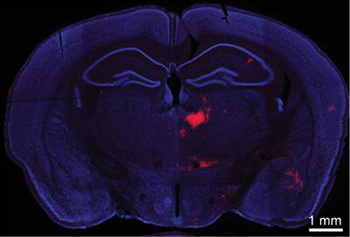
A red fluorescent marker illuminates neurons providing input to the prefrontal cortex of the brain. Credit: Li laboratory, Cold Spring Harbor Laboratory
Anatomical and behavioral data indicate that disruptions in the inhibitory circuit between the thalamus and the prefrontal cortex (PFC) in the brain could be the source of several types of cognitive disorders, but the exact mechanisms behind the faulty wiring remain unknown. A team from Cold Spring Harbor Laboratory (CSHL, USA) used optogenetic stimulation—a method of lighting up active neurons—to image active neurons in the inhibitory circuit between these two brain structures. This demonstration may someday inform new circuit-specific treatments for cognitive disorders such as schizophrenia (J. Neurosci., doi: 10.1523/JNEUROSCI.4565-14.2015).
Using optogenetic stimulation, the CSHL team, led by Bo Li, labeled neurons in the mouse thalamus with a light-sensitive protein. When these labeled neurons were activated with blue pulses of light, they fluoresced red. The researchers observed that the activated thalamus neurons “recruited” other neurons along the inhibitory circuit, resulting in the activation of inhibitory paravalbumin-expressing interneurons and excitatory pyramidal neurons in the PFC. This demonstration provided a visual confirmation that activated neurons in the thalamus drive the inhibitory circuit, controlling the flow of information that runs between the two brain structures.
Li says, “[disruptions in] the PFC and thalamus have been implicated in schizophrenia in studies of humans as well as animal models.” The authors hope that their research helps to map the specific pathways responsible for schizophrenia and other disorders marked by cognitive impairments, and that these insights can help guide development of improved treatments that target and reverse these disruptions.
